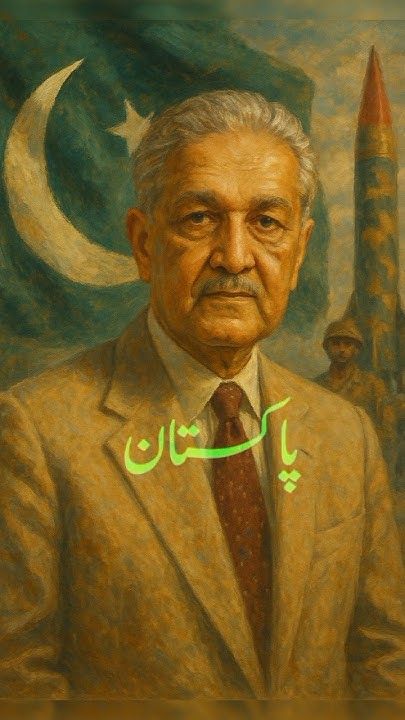On May 28, 1998, the remote mountains of Chagai in Balochistan echoed with a sound that changed the course of history. It was not merely an explosion; it was a declaration. Pakistan had entered the elite club of nuclear-armed nations, asserting its right to security, sovereignty, and self-reliance. The event, known today as Youm-e-Takbeer (the Day of Greatness), symbolizes more than a technological milestone—it represents the will of a nation to defend itself and stand tall in the face of adversity.
Pakistan’s nuclear journey is not one of aggression but of strategic necessity. It is rooted in regional dynamics, scientific determination, and the unwavering belief that peace is best preserved through preparedness.
The Origins: A Vision for Security and Sovereignty
The foundations of Pakistan’s nuclear program were laid in the 1950s under the “Atoms for Peace” initiative. Originally aimed at promoting the peaceful use of nuclear technology, the program took a strategic turn after the 1971 war with India and the subsequent disintegration of East Pakistan. The loss was traumatic, prompting a deep reassessment of national defense policies.
It was Zulfikar Ali Bhutto, then Prime Minister, who famously declared, “We will eat grass, even go hungry, but we will get one of our own [atom bomb].” This statement did not reflect militarism, but rather the urgency of ensuring Pakistan’s survival in a volatile region.
In the years that followed, a team of dedicated scientists and engineers, most notably Dr. Abdul Qadeer Khan, began working quietly but determinedly to achieve nuclear capability. Despite international sanctions, limited resources, and technological restrictions, their persistence laid the groundwork for one of the most significant scientific achievements in the country’s history.
The Chagai Tests: A Defining Moment
The Indian nuclear tests in May 1998 created a strategic imbalance in South Asia. Within two weeks, Pakistan responded by conducting five nuclear tests in Chagai, restoring regional equilibrium.
These tests were not only a military response but also a powerful message: Pakistan would not be coerced or cornered. The tests affirmed the country’s resolve and demonstrated its capacity for self-defense without engaging in aggression.
Pakistan’s nuclear policy was, and remains, based on the principle of minimum credible deterrence. It ensures that while the nation does not seek war, it retains the capability to defend itself against external threats.
Responsible Stewardship: Deterrence, Not Domination
Unlike some nuclear powers, Pakistan has consistently projected its nuclear arsenal as a deterrent, not a tool for dominance. The country has established strong command-and-control mechanisms, ensuring the safety and security of its nuclear assets.
Key features of Pakistan’s nuclear policy include:
-
No first-use doctrine against non-nuclear states
-
Strict non-proliferation stance
-
Commitment to regional peace and stability
Despite criticism and skepticism from certain quarters, Pakistan has maintained restraint and responsibility in its nuclear behavior. It has proposed several arms control and disarmament initiatives within the South Asian context, although these have largely been ignored by its regional rivals.
Beyond Defense: Peaceful Applications of Nuclear Energy
While defense remains a core aspect of the nuclear program, Pakistan has also invested significantly in the peaceful use of nuclear technology.
-
Energy Production: Nuclear power plants in Karachi (KANUPP) and Chashma provide thousands of megawatts of electricity to the national grid, offering a cleaner alternative to fossil fuels.
-
Healthcare: The Pakistan Atomic Energy Commission (PAEC) operates over 18 nuclear medical centers across the country, treating thousands of cancer patients annually.
-
Agriculture & Industry: Nuclear techniques are used to improve crop yields, food preservation, and pest control, contributing to food security.
This dual approach underscores Pakistan’s commitment to science for development, and its capability to harness nuclear energy for both defense and welfare.
Global Challenges and Diplomatic Complexities
Despite its responsible posture, Pakistan remains outside key global frameworks like the Nuclear Non-Proliferation Treaty (NPT) and the Nuclear Suppliers Group (NSG). These exclusions are largely political, stemming from its status as a non-signatory.
However, Pakistan has consistently argued for a criteria-based approach rather than a selective one. The country seeks fair access to nuclear technology and international cooperation, especially when it comes to peaceful uses of atomic energy.
The road to global nuclear legitimacy is challenging, but Pakistan continues to engage in nuclear diplomacy, emphasizing transparency, safety, and a regional arms balance.
Public Sentiment: National Pride and Unity
In Pakistan, the nuclear program is not just a scientific achievement; it is a symbol of national pride, resilience, and identity. For many, it represents what the country can accomplish when united by purpose and vision.
Educational institutions often celebrate Youm-e-Takbeer with seminars and lectures. The media revisits stories of scientists and policymakers who shaped the program. It’s a moment of reflection on how determination can overcome limitations.
Amid political turmoil, economic struggles, and social challenges, the nuclear program remains a rare unifying force, reminding Pakistanis of their potential and perseverance.
The Future: From Strength to Sustainability
Moving forward, Pakistan must balance its nuclear responsibilities with regional peace-building efforts. The focus should now shift from stockpiling to:
-
Regional dialogue on arms control
-
Investment in nuclear safety technologies
-
Expansion of civilian nuclear applications
-
International collaboration on clean nuclear energy
As climate change and energy insecurity loom large, nuclear power could play a key role in Pakistan’s sustainable development. With proper support, Pakistan could emerge not only as a nuclear power but also as a leader in peaceful atomic innovation.
Conclusion: A Legacy of Strength and Restraint
Pakistan’s nuclear program is more than a military deterrent. It is the story of a nation that turned vulnerability into strength, and isolation into innovation. It reflects a deep understanding that true power lies not in threats, but in the ability to protect peace through preparation.
In a region fraught with instability, Pakistan’s nuclear capability continues to serve as a balancing force. But it is also a reminder that science, when guided by ethics and responsibility, can build bridges, save lives, and illuminate paths to progress.
For more stories on national security, science, and development, visit Myinewsworld.com — where vision meets voice.
This post was created with our nice and easy submission form. Create your post!




